In Roman mythology, Mercury (associated with the Greek deity Hermes) (pronounced /ˈmɝkjəri/, Latin: Mercurius ![]() listen (help·info)) was a messenger, [1] and a god of trade, profit and commerce, the son of Maia Maiestas and Jupiter. His name is related to the Latin word merx ("merchandise"; compare merchant, commerce, etc.). In his earliest forms, he appears to have been related to the Etruscan deity Turms, but most of his characteristics and mythology were borrowed from the analogous Greek deity, Hermes.
listen (help·info)) was a messenger, [1] and a god of trade, profit and commerce, the son of Maia Maiestas and Jupiter. His name is related to the Latin word merx ("merchandise"; compare merchant, commerce, etc.). In his earliest forms, he appears to have been related to the Etruscan deity Turms, but most of his characteristics and mythology were borrowed from the analogous Greek deity, Hermes.
Mercury has influenced the name of a number of things in a variety of scientific fields, such as the planet Mercury, and the element mercury. The word mercurial is commonly used to refer to something or someone erratic, volatile or unstable. The term comes from astrology and describes the expected behavior of someone who has the planet Mercury passing through their astrological sign.
Worship
Mercury did not appear among the numinous di indigetes of early Roman religion. Rather, he subsumed the earlier Dei Lucrii as Roman religion was syncretized with Greek religion during the time of the Roman Republic, starting around the 4th century BC. From the beginning, Mercury had essentially the same aspects as Hermes, wearing winged shoes talaria and a winged petasos, and carrying the caduceus, a herald's staff with two entwined snakes that was Apollo's gift to Hermes. He was often accompanied by a cockerel, herald of the new day, a ram or goat, symbolizing fertility, and a tortoise, referring to Mercury's legendary invention of the lyre from a tortoise shell. Like Hermes, he was also a messenger of the gods and a god of trade, particularly of the grain trade. Mercury was also considered a god of abundance and commercial success, particularly in Gaul. He was also, like Hermes, the Romans' psychopomp, leading newly-deceased souls to the afterlife. Additionally, Ovid wrote that Mercury carried Morpheus' dreams from the valley of Somnus to sleeping humans.[2]
Circus Maximus, between the Aventine and Palatine hills, was built in 495 BC. This was a fitting place to worship a swift god of trade and travel, since it was a major center of commerce as well as a racetrack. Since it stood between the plebeian stronghold on the Aventine and the patrician center on the Palatine, it also emphasized the role of Mercury as a mediator.
Because Mercury was not one of the early deities surviving from the Roman Kingdom, he was not assigned a flamen ("priest"), but he did have a major festival on May 15, the Mercuralia. During the Mercuralia, merchants sprinkled water from his sacred well near the Porta Capena on their heads.
Syncretism
When they described the gods of Celtic and Germanic tribes, rather than considering them separate deities, the Romans interpreted them as local manifestations or aspects of their own gods, a cultural trait called the interpretatio Romana. Mercury in particular was reported as becoming extremely popular among the nations the Roman Empire conquered; Julius Caesar wrote of Mercury being the most popular god in Britain and Gaul, regarded as the inventor of all the arts. This is probably because in the Roman syncretism, Mercury was equated with the Celtic god Lugus, and in this aspect was commonly accompanied by the Celtic goddess Rosmerta. Although Lugus may originally have been a deity of light or the sun (though this is disputed), similar to the Roman Apollo, his importance as a god of trade and commerce made him more comparable to Mercury, and Apollo was instead equated with the Celtic deity Belenus.[2]
Mercury was also strongly associated with the Germanic god Wotan; 1st-century Roman writer Tacitus identifies the two as being the same, and describes him as the chief god of the Germanic peoples. Julius Caesar, in a section of his "Gallic Wars" describing the customs of the German tribes, wrote "The Germans most worship Mercury," apparently identifiyng Wotan with Mercury.
In Celtic areas, Mercury was sometimes portrayed with three heads or faces, and at Tongeren, Belgium, a statuette of Mercury with three phalli was found, with the extra two protruding from his head and replacing his nose; this was probably because the number 3 was considered magical, making such statues good luck and fertility charms. The Romans also made widespread use of small statues of Mercury, probably drawing from the ancient Greek tradition of hermae markers.


